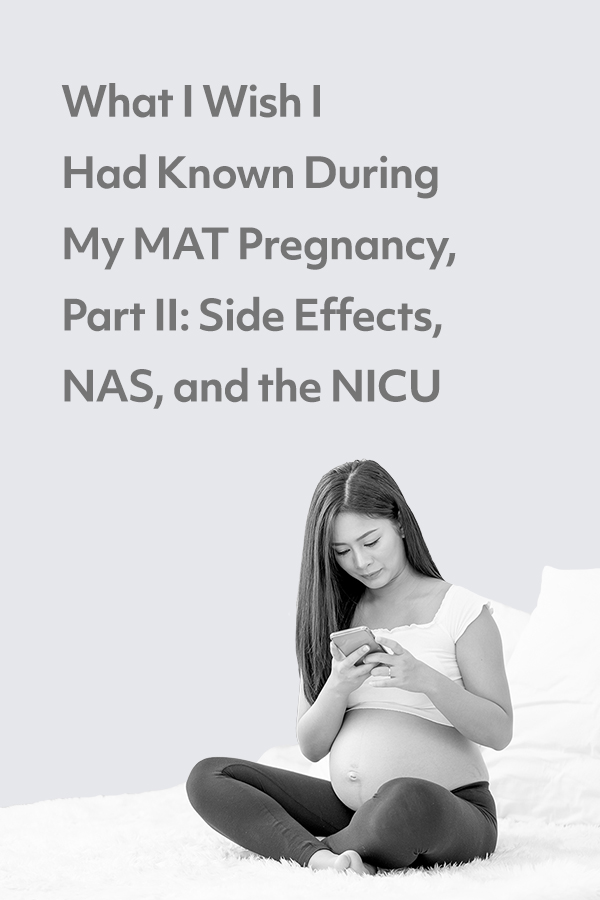Over the course of two pregnancies, I experienced two different medications—methadone and buprenorphine—in my medically-assisted treatment for opioid use disorder.
I gave birth to the older of my two daughters while taking methadone to treat addiction to heroin. By the time I had my second daughter, I had switched to buprenorphine. I’m not a treatment professional, but I am in a unique position to speak about my experiences with medically-assisted treatment (MAT) and pregnancy due to my experiences with the two dominant medications used by pregnant women in recovery.
This is part two in a three-part series about MAT and pregnancy. In part one, I discussed stigma and the likelihood of birthing an infant who experiences neonatal abstinence syndrome (NAS). Here in part two, I will share some of the side-effects I experienced, and some recent research that may help reduce some of those side-effects as well as the risk or severity of NAS.
Side-Effects of Medication-Assisted Treatment During Pregnancy: Methadone
On methadone, the main side-effect I experienced was sleepiness. In the morning, I awoke to a feeling of restlessness that felt like the early signs of withdrawal. About two to three hours after dosing, I’d begin to fall asleep. As I describe in a Vox article about using methadone during pregnancy, “When my dose peaked, about three hours after ingestion, I fell asleep. Sitting at a desk in writing class, knees crossed for meditation group, slumped against the bus window—wherever I was when that medicine hit, I slept.”
Though I’m not the first person to report this side effect, it may be preventable. According to research by John McCarthy, a doctor who has spent over four decades treating pregnant women using methadone, sleepiness experienced during methadone’s metabolic peak may indicate that the dose is too high (at least at that concentrated dose), even if the woman shows signs of withdrawal in the morning. Many clinics, including mine, treat morning withdrawal during pregnancy by raising the woman’s dose. But according to McCarthy’s research, this leads to maternal and fetal sedation a few hours after dosing.
How can those side effects be reduced? One method is to offer pregnant women split-dosing. Because a woman’s metabolism changes radically during pregnancy, she may need her medically-assisted treatment to be administered two or more times daily. This allows her medication levels to remain stable, rather than peaking a few hours after dosing and then waning later. Unfortunately, many clinics (including mine) opt to raise a pregnant woman’s single dose instead, resulting in the cycle I experienced, of sleepiness followed by mild withdrawal. (This is going to come up again later.)
Side Effects of Medication-Assisted Treatment During Pregnancy: Buprenorphine
I experienced fewer intrusive side effects on buprenorphine than on methadone, but it should be noted that my dose was significantly lower. Buprenorphine is stronger than methadone, in that most people require a lower relative dose to benefit from the effects. Even with that in mind, my buprenorphine dose was very low during my pregnancy. When I discovered I was pregnant, I was at the tail end of a buprenorphine taper. I discovered I was pregnant when I was down to .5 mg. It’s possible I could have jumped off and my baby would have been fine, but I decided not to take the risk, especially because I experienced withdrawal when I tried.
I was a bit sleepy during this pregnancy, but that commonly happens during pregnancy. The sleepiness was not as pronounced as what I experienced on methadone. I also felt considerably calmer than I had during my previous pregnancy. This can likely be attributed to several factors. First, when I discovered I was pregnant with my first daughter, I was still actively using heroin. The nine months of that pregnancy were also the first nine months of my recovery. Early recovery is always tough.
Finally, a few small studies have reported that buprenorphine may help alleviate some symptoms of post-traumatic stress disorder (PTSD), a condition which I have. I’ve found that buprenorphine helps relieve some (though definitely not all) of the anxiety and mood swings that result from PTSD. It’s possible that this effect of buprenorphine helped keep my emotions relatively balanced during my pregnancy.
In terms of negative side effects, I felt slight mental fog on buprenorphine, though that is commonly associated with both pregnancy and PTSD. I also experienced some “creative blunting,” meaning that I felt less of an imaginative spark for my creative writing. However, it’s difficult to pinpoint whether that was the result of the medication, the pregnancy, trauma, stress, or a combination of any of these factors. One study found that long-term buprenorphine users experienced flattened affect and reduced awareness of positive emotional states.
Reducing the Chances of Neonatal Abstinence Syndrome (NAS)
It is impossible to completely eliminate the chance that your infant will experience NAS. Withdrawal is a very real possibility for infants whose mothers use opioids—prescribed or not—during pregnancy. Weighed against the other possible outcomes (maternal relapse, miscarriage, or birth defects), MAT is still a very good option for pregnant women in recovery from addiction.
Even though you can’t totally eliminate the possibility that your baby will experience NAS, there are ways to reduce the possibility and severity of symptoms. The first thing to remember is what will not reduce the chances: a low dose. Many women, including myself, think that keeping on a low dose of methadone or buprenorphine will ensure her child does not have withdrawal. That is simply not true. Take me, for example: I began on 20mg of methadone, and slowly went up to 60mg. 60mg is a lower dose than many people take, and is even considered by some doctors to be below the threshold for a therapeutic dose. (including Mary Jeanne Kreek, who helped develop methadone treatment for addiction). And I already mentioned that I was on a very low dose of buprenorphine. But despite these low doses, both of my daughters experienced some withdrawal. The daughter who was born while I was on methadone experienced fairly significant withdrawal for over a month. On the other hand, this doesn’t mean that higher doses will stave off withdrawal either! So don’t ask your doctor to raise your dose by 30 mg without reason.
Staying Out of Withdrawal
Remember when I said that split dosing would come up again? That same research found that the best way to reduce the chances of NAS was to keep the mother out of withdrawal. Which is, of course, part of the purpose of MAT during pregnancy. But the response that my clinic shared with many others around the United States—raising a mother’s single dose when she begins to experience withdrawal—may not be the right one. Offering split dosing during pregnancy and raising the dose when necessary will keep the mother’s medication levels stable, which translates into keeping her out of withdrawal. And in McCarthy’s study, following this dosing model meant that only 29% of infants experienced withdrawal, as opposed to 60%-80% during the more common treatment course.
Unfortunately, while some clinics do offer split dosing for pregnant patients, many others have strict policies against it. There is no database detailing how many clinics offer split dosing, but the fact that this relatively simple practice is not implemented at every clinic presents a significant problem. If you’re pregnant and your clinic or provider won’t offer you split dosing, contact your State Opioid Treatment Authority and advocate for yourself and your child.
No NICU
The Neonatal Intensive Care Unit (NICU) is a hospital ward where infants are sent when they experience a significant health condition that requires medical intervention. Premature infants are sent there, some jaundiced infants, and newborns with other serious health conditions. Many hospitals, including the ones where my daughters were born, also send babies who show symptoms of NAS to the NICU. But experts say that is the wrong thing to do.
If you want to keep your baby from suffering too greatly, keep her near you. Maternal bonding, breastfeeding, and skin-to-skin contact are far better at soothing infants than a dose of morphine or rounds of surveillance in a separate hospital ward. The bright lights and noisy environment in the NICU may also aggravate the baby’s NAS symptoms, causing her to score higher on the symptomatic index staff use to determine her withdrawal levels.
Unfortunately, hospitals dictate infant care. Even if you want to room-in with your child and breastfeed, the hospital staff may not let you. When my first daughter was born, I was forced to pump milk and visit her on a schedule while she stayed in the NICU for over a month. When my second daughter was born, I was more adamant. I was also in a more welcoming hospital. Although she was initially placed in the NICU, I was allowed to breastfeed. I continued to ask for a room with her until I finally got it. And she was home in under two weeks.
The severity of NAS ranges. Some babies experience sneezing, while others have seizures. If your child is on the seizure end of NAS, she may require that extra observation and care provided by the NICU. But if her symptoms are not life-threatening, try your best to advocate that she stay with you instead of the NICU. If that doesn’t happen, don’t blame yourself. Some hospitals are more open to listening than others.
Thank you for reading about my experiences with MAT and pregnancy. If you haven’t read part one yet, you can find it here. For part three, I’d like to answer some of your questions. Have a burning question about MAT and pregnancy that I haven’t answered yet? Leave it in the comments—I will do my best to answer what I can.





